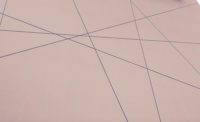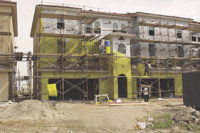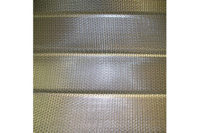There never seems to be a shortage of interesting situations in the stucco and EIFS world. With my passion for these industries and my ever-open eyes and ears-to-the-ground alertness, I find myself engaged in some very intriguing conversations usually related to a “situation.” My friend Tim Rogan was the author of a recent online conversation concerning paperbacked metal lath. He is a larger-than-life Texas contractor, complete with requisite drawl, an astute stucco and EIFS professional, fellow ASTM warrior, contributor to this very magazine and just all-around good guy. The paperbacked lath topic he blogged about was interesting enough that I felt the need to write about it so thank you Tim, keep ’em coming.
Let me make some distinctions before I venture on: when I speak of paperback lath, it is that which is to be applied over a framed and/or sheathed wall assembly. I am not referring to any application over cement or CMU or solid structure wall assembly. Nor am I offering an opinion or endorsement of any version.
The lath portion of a stucco assembly is a simple component comprised of metal or glass fiber. The most common version is expanded metal lath that is sold in sheets. Other popular types are welded wire, sold in sheets and rolls and woven netting, sold in rolls, with all three versions available either as-is or with a paper backing. Simply, the lath is there to carry the weight of the stucco and act as a stucco thickness gauge. Simply, that is, until paper is added to the back where it is then transformed into a multi-functional stucco assembly component. By taking the water resistive barriers component and attaching it to the back side of a piece of lath you have increased the importance of the installation of said component.
Let’s first take some time to roll around in the paper and spun-bonded olefin types of a WRB layer. These rolls of WRBs are the two-sheet component first layer; the water resistive protector of the building that resides under the stucco assembly and absolutely need to be installed properly.
Back to Basics
Some basics are: It needs to be applied in a weatherboard fashion. This is simply achieved by starting at the bottom of the wall with every subsequent layer overlapping the lower creating a shingling effect. It should be free of tears and holes, and applied flat with no wrinkles. It is incorporated into other WRB components, such as fenestration flashings with the same consideration of creating a shingle affect, the bottom underneath the top, always. Once again, always. All of these considerations need to be incorporated with any piercing or patching repairs or the starting of the next new roll on the wall.
I would be remiss if I didn’t mention the newer liquid-applied WRBs that are increasing in popularity for stucco claddings. Born from the EIFS industry, they are being used more and more in the stucco world. They also stem from the waterproofing industry, where they have been used below grade and under other types of claddings for some time. These are single layer, monolithic types applied wet—typically in one or two passes—that when dried become a single layer without any laps or joints or fasteners like their sheet-goods counterparts.
One caveat is that for stucco claddings, there still needs to be an additional layer of a sheet-good or an intervening layer such as foam. Paperbacked lath complies with the additional layer requirement. I am not able to comment on the performance characteristics of a liquid-applied WRB as the first layer in a two-layer required assembly compared to two layers of sheet-goods. There aren’t too many 20-year-old assemblies with this that I am aware of.
Layered Goods
So, we will continue with the time proven two-layer of sheet-goods WRBs. There are some differing opinions and practices as to the orientation of two layers, but the IBC is specific (IBC Section 2510.06). It states that first the WRB needs to perform equivalent to two layers of WRB complying with ASTM E2556, Type I. It calls for the layers to be installed independently so that each layer provides a separate continuous plane. Any flashings installed that are designed to drain to the WRB layer, need to be directed between the layers. This is an important criterion when using paperback lathed products.
Back in my production lath days, we would apply a layer of black paper, then follow immediately over it with the paperbacked lath. At the top side of the lath the attached paper backing would be folded down exposing 2-3 inches of metal lath, an engineered feature for integration with the next layer. Next we would unfold the lap of paper and staple the edge to the framing member locations to secure it. Then we applied another layer of black paper being sure to lap it 2-3 inches over the two layers below. (One was the black paper from the roll the other the paper attached to the lath.)
This continued all the way up the wall, an overlap of two layers in a shingling fashion. At the sides of each piece of lath, the attached paper would be beyond the metal lath on one side and short of the lath on the other. This was provided for proper integration of the WRB and lath overlap on each side. In the end the WRB was continuous, overlapped correctly but not applied in two separate continuous planes and was compliant to the codes at that time. In my humble opinion the new IBC requirement is applicable when you have two separate WRBs. Obviously, the only way with liquid WRB products and understandable with differing sheet-good products like spun-bonded and paper, but unnecessary when both layers are the same sheet-good product.
A successful application of paperbacked metal lath products begins with proper orientation of the lath, there is a top and a bottom. It has a good integration of the WRB with proper overlaps, shingled correctly and free of holes and tears. The metal lath part is also overlapped properly with the required dimension on all sides and fastened to a framing member. At the edge laps the overlap occurs at a framing member and is fastened, or is tied together between framing members.
An improper application, one that gets the professionals to blog and columnists to write, is when the paperbacked lath is just run without proper integration. If the paper from the next sheet overlap the wire of the sheet below, the stucco will crack. If the ends are just fastened to the sheathing between framing members, the stucco will crack. If the metal lath has too much of an overlap, more than 3 inches, there is a high likelihood of the stucco cracking. This is due to a lack of the stucco keying into both layers of lath thus making a weak plane. And for those of you in the extremely hot climates, if the lath is left exposed to the heat there is a chance of the adhesive holding the paper to the lath, melting.
Not that the lath is going to fall off but rather the glue is going to spread to place it is not intended to be. And, the paper when exposed to weather for an extended period could lose its performance characteristics. You know, those characteristics that keep the moisture out of your structures.
There are other versions of paperback technology the metal lath integrated with a paper backing. This type of paper backing is typically there to allow for spray applications, stopping the sprayed stucco from just going right through the wire. These versions do not have a WRB incorporated in them but may be referred to as paperbacked all the same.
Paperbacked lath products are a great time saver and have performed very successfully for many years.
It takes a little time to ensure proper integration of the multiple layers but once figured out is a quick and easy application. I might consider that this type of lath is for the more seasoned lather, the true mechanics who understand the relationship between a WRB and its attached metal lath component.







Report Abusive Comment